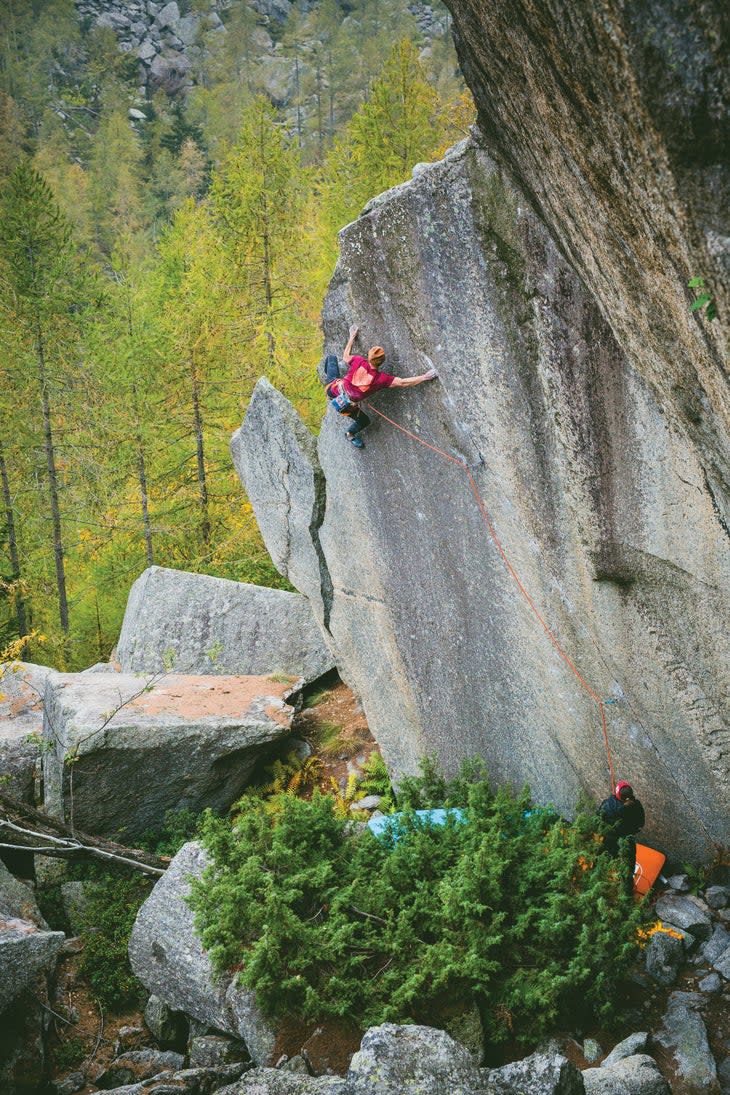Should We Rethink the Ethics of Highball Bouldering?
This article originally appeared on Climbing
For 10 years, I have developed numerous problems--including 29 Dots, a 45-foot-tall 8A+/V12 with the crux at 25 feet--in Valle dell'Orco, a remote mountain region of Italy. I climbed 29 Dots ground-up, with no toprope rehearsal. This past September, I opened Grenzenlos, my most beautiful highball and, because of the unorthodox way I did the line, perhaps one of my wildest. I wanted to boulder the 35-foot wall, but falling from the upper crux onto the rocky landing wasn't an option. So I worked it from the ground, and then toproped and eventually led it with a hand-placed Birdbeak for protection. My approach was different in the bouldering world, where rocky landings are often landscaped and crashpad stacks are employed so you can fall without risking injury.
When I see groomed landings or pads crushing bushes, small trees, and flowers, I wonder if it wouldn't be more honest just to toprope? Certainly, toproping is more environmentally sound. And what is highballing anyway when you can land softly on several feet of foam? What's next--we blow up a giant air mattress in the forest so we can fall from 30 feet or higher? Is this progression?
Highballing has always been special for me, an intense confrontation with myself. It's like a soft version of soloing. When you highball with only minimal pads, you reach a no-fall zone, and you must be sure of what you're doing up there. On Grenzenlos, my solution was unorthodox, but it was one that used only what the landscape provided. My friends offered to help construct a landing zone, but that wasn't an option for me philosophically.
Am I speaking as someone free of guilt? Definitely not. I've opened more than 1,000 problems and prepared landing zones, but when I moved the occasional log or rock, I treated it like gardening: You couldn't really notice any changes. Today, we see landing zones resembling construction sites. At Magic Wood, I've been shocked by what we, the oh-so-aware-of-nature climbers, have done. This deserves only one word: ugly.

It is time to see bouldering as more than just taking off from the crashpads and moving through tricky moves. Let's question our ecological footprint. The focus should be to respect nature. The natural world is the spectacular stage where our actions take place, and it offers myriad experiences and insights. To separate bouldering from nature is impossible. We are only guests and should behave accordingly.
Leave a place as you find it. Give other climbers and nature-lovers the chance to enjoy a beautiful environment.
I called my new problem/route Grenzenlos, German for "limitless." In 2020, a year overshadowed by the pandemic, the climb was a milestone for me. On this project, I learned that even if our freedom to move around is restricted by external circumstances, there are no limits to our minds.
This article originally appeared in Climbing in 2021. Bernd Zangerl is a top boulderer, with FAs up to V15.
For exclusive access to all of our fitness, gear, adventure, and travel stories, plus discounts on trips, events, and gear, sign up for Outside+ today.

